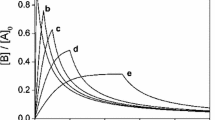Abstract
This paper establishes a number of properties of transformation groups that map elementary kinetic equations into new elementary kinetic equations with altered rate constants. The chemical significance of the transformations is assessed by applying them to systems involving two reacting species. There are then twelve one-parameter groups of mappings. Some mappings may be used to study the effects of changes in input/output fluxes on concentrations and their compensation by changes in other rate constants. A number of mappings transform nonlinear kinetics into approximately linear kinetics valid in regions larger than those obtained by standard methods. In some cases, the linearization is globally exact. Some mappings create lumped concentration variables and may be used to systematically reduce the number of manifest concentration variables in nonlinear, as well as linear, kinetic equations. The global mappings may be characterized by the functions of rate constants and functions of concentrations that they leave invariant. Although they produce large changes in rate constants and concentrations, none of these mappings change the topology of concentration phase plots as they map a phase plot determined by one set of initial conditions and rate constants into that determined by transformed initial conditions and rate constants. Metrical properties of the concentration maps generally depend upon the accuracy with which the group generators are approximated: systematic methods for their improvement are sketched.
Similar content being viewed by others
References
C.E. Wulfman and H. Rabitz, J. Math. Chem. 3(1989)
F.C. Frank, Biochim. Biophys. Acta 11 (1953)459.
A.R. Hochstim, Origins of Life 6 (1975)317.
A.J. Lotka,Elements of Physical Biology (Williams and Wilkins, 1925).
V. Volterra, Mem. Acad. Lincei 2 (1926)31; cf. also: V. Volterra,Leçons sur la Théorie Mathématique de la Iutte pour la Vie (Paris, 1931).
Cf., for example, H.T. Davis,Introduction to Nonlinear Differential and Integral Equations (U.S. Atomic Energy Commission, Washington, D.C., 1960) p. 102.
V.I. Arnold,Ordinary Differential Equations, trans. by R.A. Silverman (MIT Press, Cambridge, MA, 1973).
W.E. Boyce and R.C. DiPrima,Elementary Differential Equations and Boundary Value Problems (Wiley, New York, 1977) p. 406.
S. Lie,Vorlesungen liber Continuierliche Gruppen, Abteilung III (Chelsea, New York, 1971).
B.L. Clarke,Advances in Chemical Physics, ed. I. Prigogine and S.A. Rice, Vol. 43, (Wiley, New York, 1980) pp. 1–215;
B.L. Clarke, J. Chem. Phys. 75 (1981)4970.
M. Feinberg,Dynamics and Modelling of Reactive Systems, ed. W. Stewart, W.H. Ray and C. Conley (Academic Press, New York, 1980) pp. 59–129.
Cf. C. Wulfman and H. Rabitz, J. Phys. Chem. 90(1986) for a discussion of the determination of group generators that leave kinetic equations and additional functions or functionals invariant.
H. Rabitz and C. Wulfman, to be published.
C. Wulfman and Tai-ichi Shibuya, Rev. Mex. de Fisica 22 (1973)171.
Cf., for example, J.E. Campbell,Introductory Treatise on Lies Theory of Finite Continuous Transformation Groups (Chelsea, New York, 1966), reprint of 1903 edition.
Author information
Authors and Affiliations
Rights and permissions
About this article
Cite this article
Wulfman, C.E., Rabitz, H. Global sensitivity analysis of nonlinear chemical kinetic equations using lie groups: II. Some chemical and mathematical properties of the transformation groups. J Math Chem 3, 261–297 (1989). https://doi.org/10.1007/BF01169596
Received:
Accepted:
Issue Date:
DOI: https://doi.org/10.1007/BF01169596




